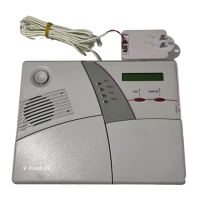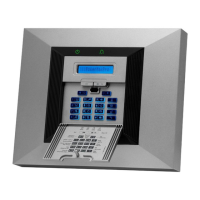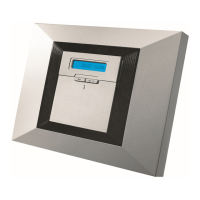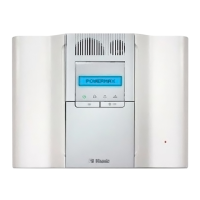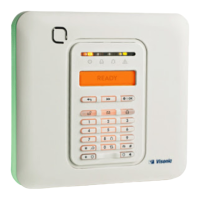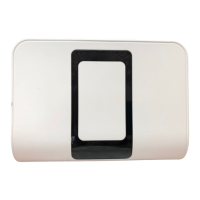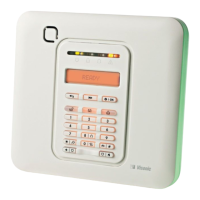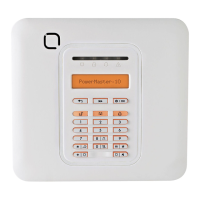12 DE5467IP
4.4.7 Quick Arm (fig. 4.4, location 07)
Here you determine whether the user will be allowed to
perform quick arming or not. Once quick arming is
permitted, the control panel does not request a user code
before it arms the system.
The two options are: quick arm ON and quick arm OFF.
4.4.8 Bypass (fig. 4.4, location 08)
Here you permit either manual bypassing of individual
zones (through the USER SETTINGS menu), or allow the
system to "force arm" (perform automatic bypassing) of
open zones during the exit delay. If desired, press the
arming key twice if you want to eliminate the delay beeps
that continue during a force arming. If a zone is open and
forced arming is not permitted, “NOT READY” is displayed
and the system does not arm (the “Sad Melody” will
sound). If "no bypass" is selected, neither manual
bypassing nor force arming is allowed.
Options: manual bypass, force arm and no bypass.
In UL installations, "force arm" must not be selected.
4.4.9 Exit Mode (fig. 4.4, location 09)
Here you determine whether the exit delay will restart if the
exit / entry door is reopened before the exit delay expires.
Restarting the exit delay is helpful if the user re-enters
immediately after going out to retrieve an item that he left
behind. Three types of exit mode are available:
Restart Exit - Exit delay restarts when the door is
reopened during exit delay. The restart occurs once only.
Off by door - When the door is closed, the exit delay is
automatically terminated (even if the defined exit delay
was not completed).
Normal - The exit delay is exactly as defined, regardless
of whether the door is open or closed.
In UL installations, "normal" must be selected.
4.4.10 Piezo Beeps (fig. 4.4, location 10)
Here you determine whether warning beeps will sound or muted
during exit and entry delays. An additional option is to mute the
warning beeps only when the system is armed “HOME”.
Options: enable beeps, off when home and disable beeps.
4.4.11 Trouble Beeps (fig. 4.4, location 11)
Under trouble conditions, the sounder emits a series of 3
short beeps once per minute. Here you determine whether
this special beeping sequence will be active, inactive, or
just inactive at night (the range of “night” hours is defined
in the factory). The 3 options are: enable beeps, off at
night (8 PM through 7 AM) and disable beeps.
4.4.12 Panic Alarm (fig. 4.4, location 12)
Here you determine whether the user will be allowed to
initiate a panic alarm by simultaneous pressing either the
two panic buttons
(on the keypad / wireless commander)
or away + home
(on a keyfob transmitter). Audible panic
activates the siren and simultaneously transmits a
message via telephone. Silent panic only transmits a
message via telephone. The options are: silent panic,
audible panic and disable panic.
Note: For UK ACPO compliance this option should be
disabled.
4.4.13 Swinger Stop (fig. 4.4, location 13)
Here you determine how many times each zone is allowed
to initiate an alarm within a single arming period (including
tamper & power failure events of detectors, PowerMax+
and wireless siren). If the alarms number from a specific
zone exceeds the programmed number, the control panel
automatically bypasses the zone to prevent recurrent siren
noise and nuisance reporting to the central station. The
zone will be reactivated upon disarming, or 48 hours after
having been bypassed (if the system remains armed).
The available options are: shut after 1, shut after 2, shut
after 3 and no shutdown.
In UL installations, No Shutdown must be selected.
4.4.14 Cross Zoning (fig. 4.4, location 14)
Do not use in UL installations.
Here you determine whether cross zoning will be active or
inactive. Cross zoning is a method used to counteract
false alarms - an alarm will not be initiated unless two
adjacent zones are violated within a 30-second time limit.
This feature is active only when arming AWAY and only
with zone couples from zone No. 18 to 27
(18 and 19, 20
and 21, etc.). You may use any one of these zone couples
to create a “cross-zoned” area.
Note: If one of two crossed zones is bypassed (see Para.
4.4.8), the remaining zone will function independently.
Note: Every 2 crossed zones must be of the allowed zone
type (Interior, Perimeter, Perimeter follower).
The options are: cross zone ON and cross zone OFF.
Cross zoning is not applicable in Entry/ Exit zones and
24h zones (Fire, Emergency, 24h audible, 24h silent).
4.4.15 Supervision (fig. 4.4, location 15)
Here you determine the time limit for reception of
supervision reports from various supervised wireless
devices. If any device does not report at least once within
the selected time limit, an “INACTIVITY” alert is initiated.
The options are: 1, 2, 4, 8, 12 hours and disable.
In UL installations, the interval must not exceed 4 h
and shall not be disabled.
4.4.16 NOT READY (fig. 4.4, location 16)
Here you determine if the system will be NOT READY
status when there is a supervision failure. In the "in
supervision" mode, the system will be in NOT READY
status if during the last 20 minutes a supervision message
was not received. Options: normal and in supervision.
4.4.17 AUX Button (fig. 4.4, location 17)
Here you select the function of the AUX button on keyfob
transmitters and wireless commanders MCM-140+. Three
options are offered:
Status: Pressing the AUX button will cause the control
panel’s voice module to announce the system status.
Instant: Pressing the AUX button while the exit delay is in
progress will cause the system to arm “instant” (the entry
delay is canceled).
PGM / X-10: Pressing the AUX button will activate the
PGM output or X-10 units (see further programming under
“DEFINE OUTPUTS”, par. 4.7).
4.4.18 Jam Detect (fig. 4.4, location 18)
Here you determine whether jamming (interfering trans-
missions, on the radio channel used by the system) will be
detected and reported or not.
If a jam detection option is selected, the system does not
allow arming under the relevant jamming conditions.
Jam Detection Options
Option Detection and Reporting when
UL (20/20)
(USA standard)
There is continuous 20 seconds of
jamming
EN (30/60)
(Europe standard)
There is an accumulated 30 seconds of
jamming within 60 sec.
class 6 (30/60)
(British standard)
Like EN (30/60) but the event will be
reported only if the jamming duration
exceeds 5 minutes.
Disabled (no jamming detection and reporting).
4.4.19 Latchkey (fig. 4.4, location 19)
Here you determine whether the system can be armed in
the latchkey mode. If the system is armed this way, a
“latchkey” message will be sent to specific telephones
upon disarming by a “latchkey user” (users 5-8 or keyfob
transmitters 5-8). This mode is useful when parents at
work want to be informed of a child’s return from school.
You can record a name for latchkey users.
The options are: Latchkey ON and Latchkey OFF.
In UL installations, this function shall not be used.

